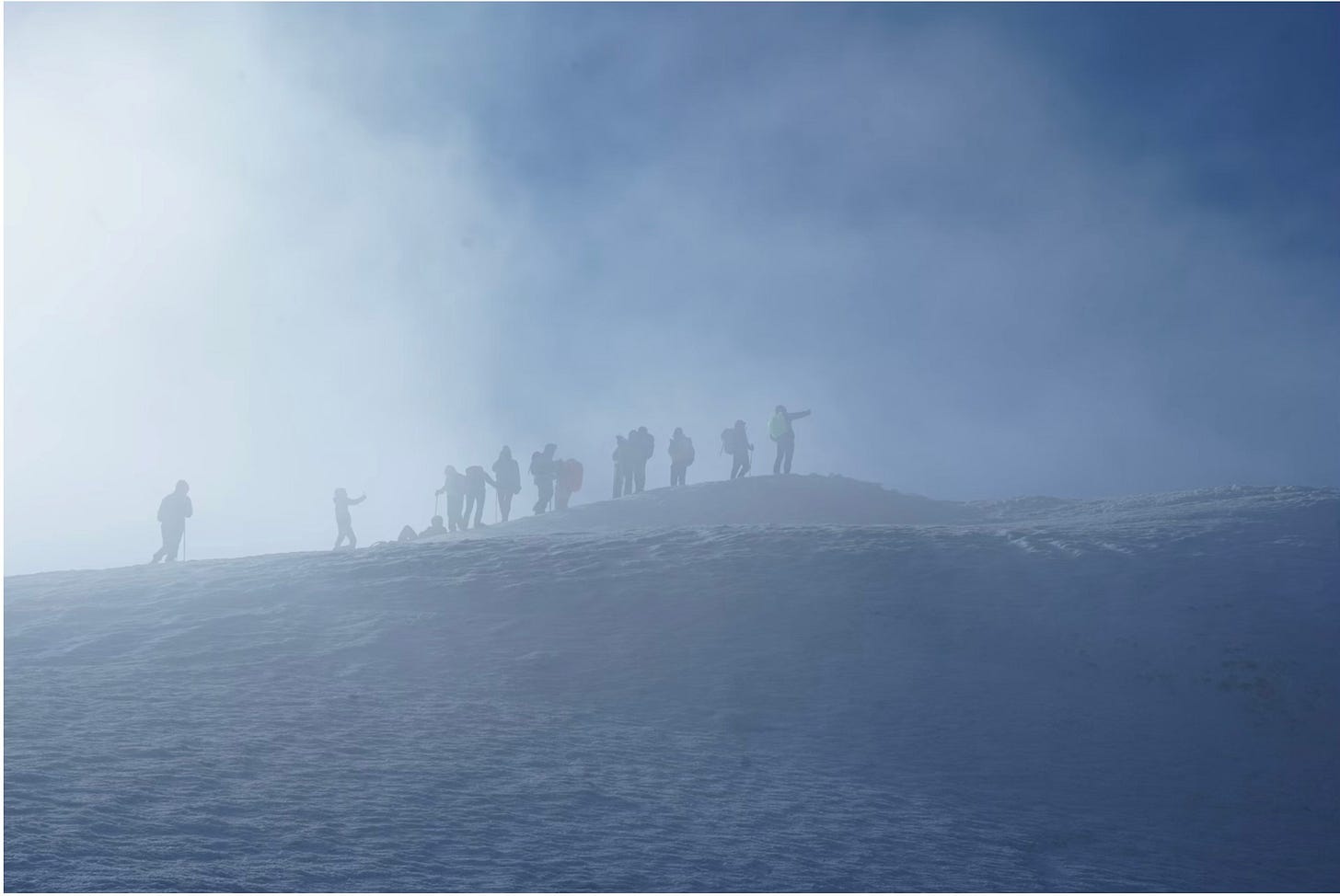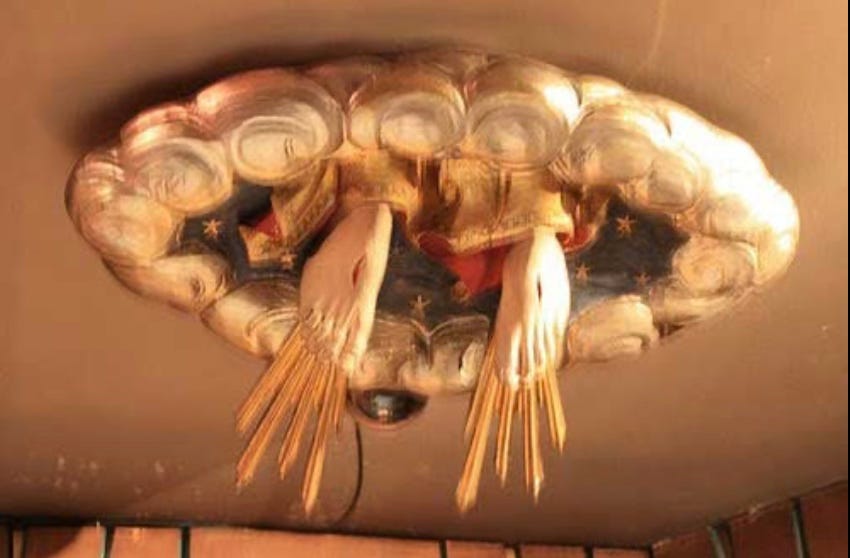Going Beyond: A Contemplative Interpretation of the Ascension
An Honest Engagement with the Lectionary Gospel of John 17:20-26 for 7th Sunday of Easter Season
Of all the great paradoxes and mysteries of the Christian tradition, the Ascension of Jesus is the one I most struggle to embrace. I don’t mean this in a purely intellectual sense, although I admit that the rational mind reels at the image of Jesus lifted into the sky like a figure from myth or fable through some form of invisible lift or elevator.
For example on the chapel of the Ascension in the Anglican Shrine of Our Lady of Walsingham which for me personally, is one of the most unspiritual and frankly ridiculous spiritual representations in a worship space that always make me laugh out loud as it borders on the comical. Sorry I know that is not very spiritually tolerant, but I need to be honest - seeing Jesus’ feet sticking out like he has fallen through the ceiling is truly ridiculous.
I struggle with it because it sits at the farthest edge of comprehension—not only in terms of physics and cosmology, but also in terms of what it means for us, here and now, to live in relationship with the risen yet ascended Christ.
Other supernatural paradoxical elements of the Gospel - virgin birth, bodily resurrection, walking on water - have become familiar enough through years of contemplation, theological wrestling, and sacramental participation that I can hold them gently in the space of mystery. They sit in the open hands of my faith like luminous stones: solid, strange, but beautiful. The Ascension, though, slips between my fingers. Jesus rising into the clouds, vanishing from the sight of his friends, no longer bound by space or time, no longer present in the same way - this leaves me unsettled, even sad. It feels like a departure. An absence. And as someone who has been scarred by childhood abandonment issues, (much therapy to be released from those particular wounds) the Ascension is troubling, and I cannot imagine how hard it must of been for the disciples come apostles to experience this. They must have felt as if they had smoked something illegal. And yet, paradoxically, the tradition insists the Ascension is the beginning of a deeper presence.
What can we do with such a moment as contemplatives - those of us drawn not simply to have to believe or explain, but to rest in the Presence that lies behind all presence? What does it mean that Jesus ascends - that he is taken from sight, not to abandon us, but to be more fully with us in all places and times?
There is something here that defies logic, and perhaps that is precisely the point. The Ascension cannot be an event to be grasped by the intellect alone. As I have said before, it is not a puzzle to be solved but a threshold to be crossed - not with the mind full of controlling and heady rationalism, but with the heart open to trans-rational knowing. It asks something of our contemplative practice that we are often reluctant to give: surrender. The surrender of needing to see in order to believe. The surrender of logical knowing where Jesus is, in order to trust that he is, in fact, here.
This is the moment when we stop clinging to a God we can touch and attempt to control and instead begin to open ourselves to the God who dwells within. In the Ascension, Jesus ceases to be a localised physical presence and becomes instead the indwelling Christ. As the mystics have always said, he leaves us so that we might find him more intimately, not beside us as another, but within us as our own deepest truth. This feels utterly true for me in the guts so that I can get beyond my agnosticism of the Ascension as a physical reality. “I am with you always,” he says—not just beside you, but within you, closer than breath.
In this light, the Ascension is not abandonment, but transformation. Christ moves from the visible to the invisible, from the physical to the mystical, not to distance himself from humanity but to become present to all creation at once everywhere. It is not about going up, but going beyond. Beyond place, beyond time, beyond the boundaries we place around reality. And so, if we are to meet him now, it must be in a different way. We must begin to see not with our eyes but with the eyes of the heart.
Contemplative practice becomes essential here. It teaches us to attune ourselves to the subtle presence of the risen Christ—not through the fireworks of certainty or spectacle, but through the quiet attentiveness of love. When we sit in silence, in openness, in watchful waiting, we are doing what the disciples did after the Ascension. We are waiting in the upper room of our own hearts for the Spirit to come. We are trusting that absence is not the final word. We are letting go of the Christ we thought we knew in order to receive the Christ who knows us fully.
There is an old saying in the contemplative tradition: “The cloud of unknowing is the way to the knowing of love.” This is precisely the path the Ascension invites us to walk. Jesus disappears into a cloud - into mystery, into unknowing - and invites us to follow. Not to grasp, not to hold, but to allow ourselves to be drawn into the depth of divine love that is no longer “out there” but “in here.” We move from relating to Jesus as an external teacher to recognising him as the indwelling Word, the silent presence at the heart of all things.
This mystery is not meant to be understood, but inhabited. The Ascension stretches us, asking us to live by faith, not as intellectual assent but as a kind of spiritual perception - a way of seeing what cannot be seen. And this is where contemplation comes into its own. In prayerful silence, in breath, in stillness, we begin to glimpse something of this deeper presence, this boundless Christ who fills all in all.
So what does it mean to live contemplatively in light of the Ascension? It means allowing the mystery of Christ’s presence to take root in our own being. It means seeking him not in the clouds, but in the ordinary world, in the poor, the wounded, the hidden places of the world - and in the quiet recesses of our own souls. It means trusting that even in moments of absence or doubt, he is nearer than we think.
Let us then turn, in closing, to a simple contemplative practice to help us rest in the presence of the ascended Christ - not as an idea, but as a reality.
Contemplative Prayer: The Practice of Inner Gaze
Find a quiet space. Sit comfortably and allow your body to be still. Close your eyes gently.
Bring your attention to your breath. Let it be natural. Simply follow the rising and falling of your chest or the gentle flow of air in and out of your nostrils.
As thoughts come, let them pass like clouds across the sky. Gently return your awareness to the breath.
After a few moments, bring your attention to your heart. Imagine the centre of your chest gently glowing with light. This is the place where Christ dwells within you.
Let your mind rest in this light—not trying to see or feel anything specific, but simply trusting that he is here, present, within.
Repeat inwardly the words: “Christ in me, Christ with me, Christ beyond me.” Let the rhythm of the words guide you deeper into silence.
Remain here for 5 to 10 minutes or longer, simply resting in the presence that is beyond understanding but not beyond love.
When you are ready, slowly open your eyes. Take a deep breath. And carry this quiet awareness with you as you return to the world.
Christ has ascended—not to leave us behind, but to draw all things into himself. Let us live, then, with hearts lifted, rooted in the mystery that Christ is here. Now. Always.
Photo by Olena Kamenetska on Unsplash




Great article! And hillarious the feet of Jesus, comical indeed!
The ascension is something i’ve thought about more deeply in the past few years. I’ve been struck by how it empowers the disciples (and us) to be partners with Christ in His work in ways we couldn’t if he were here “micromanaging” us. I think by “leaving” he is empowering us to participate more fully, He trusts us to do this work, in ways we hardly even believe is possible. The disciples, those hicks from the sticks, change the world in the space of just a few years! And like Jesus promises - you will do even greater works than i. The long term change Christianity has wrought is indeed spectacular!
Wrestle on!
I read your reflection as a repost by Christine Sine, and it brought to mind an artwork I created a couple years ago. Wishing I could share the images here, but a link will have to do - https://vondadrees.com/2023/03/17/finding-our-rhythm-ascension/. (The painted image can be found from the link at the end.) Sorry about a bit of wild goose chase via the links. Mostly, I want to express my appreciation for your words.